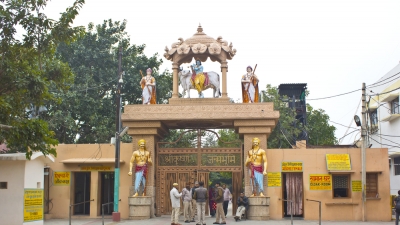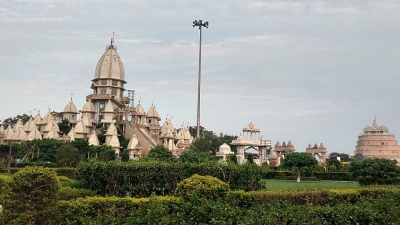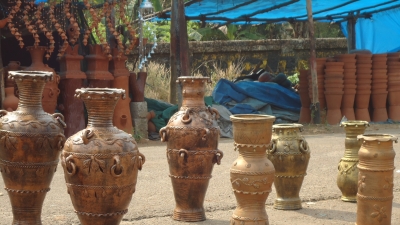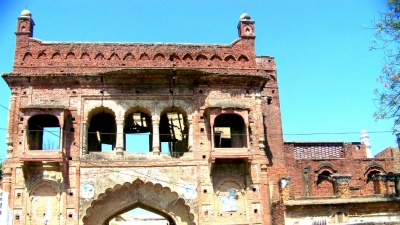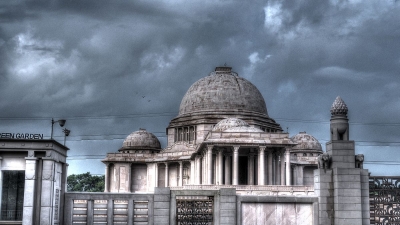Hastinapur Attractions - Tourist Places To Visit In Hastinapur
-
01Digambar Jain Bada Mandir
 + Read More
+ Read MoreHastinapur is regarded as the Tirath Khestra - a great pilgrim centre - by the Jain community. The Digambar Jain Bada Temple is the oldest Jain shrine in the city. As the word, bada, suggests, this is really a very big temple. It is located on a 40 ft high hillock. The magnificent temple stands on a 4 ft high plinth and is topped with an artistically built long spire.
The alter, with three gates, holds the white coloured statue of Bhagwan Shantinath, the main deity of the temple, sitting in Padamasana. A unique feature of the temple is that it is built like a spiral all through its height. The interior is covered with gold paintings depicting stories from Jain scriptures.
It is believed that approximately 7-8 kg of gold was spent in embellishing the interiors. The temple compound also houses a library, Vradashram, Jal Mandir, Acharya Vidyanand Museum and Kailash Parvat. It also provides a host of facilities to devotees including accommodation and dining.
-
02Ashtapad
 + Read More
+ Read MoreAshtapad means eight steps. According to Jain scriptures, there is an Ashtapad spiritual centre somewhere in the snow-clad Himalayan ranges. It is located approximately 168 miles in the north of Badrinath as one travels to Kailash Parbat. It is believed to be nearly seven miles from the fabulous Mansrovar Lake, now under Chinese possession.
According to legends, Bhagwan Rishabhdev, the first Tirthankar attained salvation at this place. Maharaja Bharat Chakravarti, his son built a palace on Ashtapad Mountains and decorated it with diamonds. It is also believed that those who visit Ashtapad attain salvation. With this belief in view, the Jain community has built a replica of the Ashtapad in Hastinapur, the birth place of the first teerthankar.
The magnificent teerath was completed in two long decades at the cost of Rs. 25 crores. The 151 ft tall, 108 diameter palatial structure can be reached through four gates. It has eight padas or steps and each step is108 ft in height.
-
03Jain Jambudweep Mandir
 + Read More
+ Read MoreJain Jambudweep Mandir owes its construction to the tireless and dedicated efforts of a highly revered Jain Saadhvi, Param Pujya Shiromani Shri Gyanmati Mataji. It is said that saadhvi saw the vision of a grand Madhyalok-Middle Universe along with thirteen islands – Terahdweep, while she was meditating below the sacred idol of Bhagwan Bahubali in the Vindhya Mountain in 1965.
What she saw in her vision was authenticated by the similar descriptions in Jain scriptures such as Tiloypannatti and Triloksar dating 2000 years back. It is believed that the first Jain Tirthankar Lord Rishabhdev, or Yuvrar Shreyans of Hastinapur also saw Sumeru Mountain in his dream. The sadhvi started a padyatra (journey on foot) throughout the country to look for the right venue.
She finally landed in Hastinapur and decided to realize her dream project at this holy place. The foundation stone of the temple was laid in 1974 and it was completed in 1985. The structure of the temple depicts the model of the universe according to Jain geography. It houses the 101 ft tall Sumeru Parbat in the centre and a 250 ft-diameter Jambudweep having four regions in its four sides: East, West, North and South.
-
04Jambudweep
 + Read More
+ Read MoreJambudweep is an island type temple complex in the famous Jain pilgrim city of Hastinapur. It is believed that the revered Jain Sadhvi Poojya Aryika Ratna Gyanmati Mataji saw its vision in the course of her meditation before the idol of Bhawan Bahubali in the Vindhya Mountain ranges in 1965.
The authenticity of her vision was later confirmed when it was found that its description matched the one provided in the 2000 year old Jain scriptures. It is believed that the first Jain Tirthankar Lord Rishabhdev also saw the same vision in his dream.
Jambudweep is, in fact, the structural representation of the concept of the world geography as portrayed by Tirthankars in the religious books. The model of the island, based upon the scriptural descriptions, was built by the Trilok Shodha Sansthan, Hastinapur.
It hosts the legendary Sumeru Parvat, the highest and the biggest range running into millions of miles somewhere in the Universe. Sumeru Parvat in Jambudweep is 101 ft high. It has Chaityalayas, rivers, hills and the fabled Lavna Samudra.
-
05Old Pandeshwar Temple
 + Read More
+ Read MoreHastinapur, meaning the city of elephants, was the capital city of Kauravas in the times of Mahabharat. While the war between Kauravas and Pandavas was fought in Kurukshetra, its seeds were actually sown in Hastinapur. After the War of Mahabharata, Hastinapur was ruled over by the Pandavas.
Located in the ruins of the old city of Hastinapur, Old Pandeshwar Temple is dedicated to God Shiva. According to the legends, the Shivling housed in the sanctum sanctorum of the temple was donated by danvir Karan, the eldest brother of the Pandavas, who was considered to be the greatest philanthropist of his times.
Karan was one of the greatest heroes of Mahabharata, who fought on the side of Kauravas. The temple is located below the idol of Goddess Kali built by the Bengali community on the top of a small hillock. It offers a spectacular view of the city of Hastinapur and its surroundings.
-
06Lotus Temple
 + Read More
+ Read MoreAlso popularly known by its Hindi version, Kamal Mandir, Lotus Temple is located in the courtyard of the legendary Jambudweep Temple. The small yet beautiful temple was built in February 1975. It houses the idol of Lord Mahavir. The temple draws huge crowds of devotees, pilgrims and visitors who make generous donations as part of their worship.
They light diyas (earthen lamps) and offer chhattras - golden umbrellas - for the fulfillment of their wishes. The temple is situated close to the 101 ft high Sumeru Parvat-mountain, whose Pandushikha or the topmost point, pinnacle, can be reached after climbing 136 inner steps of the flight of stairs.
The top of the Sumeru Parvat offers spectacular views of the mountains, rivers, temples, gardens of the Jambudweep as well as the woods surrounding the city. According to Jain scriptures, Sumeru Parvat is the most sacred and the highest mountain in the universe. All the Jain Tirathankars were anointed at this mountain. This explains why its model has been built in the temple.
-
07Shri Shwetambar Jain Temple
 + Read More
+ Read MoreThe city of Hastinapur is mentioned with great reverence in the Jain sacred texts. Starting with Bharat Chakravarti, it is the birthplace of six out of the twelve Chakravartis, besides Bhagwan Parsuram of Ramayana fame.
The historic Jain temple of Shri Shwetambar houses ancient idols. It remained in a state of neglect until it was visited by Acharya Vijay Samudra Suri Ji of Vijay Vallabh Suri Ji sect in 1960. The great Acharaya got it renovated by constructing a pinnacle on it. He placed the main idol of Shri Shantinath Bhagwan which was flanked by idols of Shri Kunthunath Bhagwan and Shri Arnath Bhagwan housed in separate structures.
The significance of this temple can be imagined from the fact that the first Jain Tirthankar, Bhagwan Shri Adinath broke his 13 month fast here after taking cane juice from Shreyans Kumar. The temple boasts of a grand paarna, or fast breaking- hall situated in front of it. It can accommodate thousands of pilgrims who come here every year on Akshay Tritiya to break their fast after a year long varsi-tapp.
-
08Bhai Dharam Sing Gurdwara
 + Read More
+ Read MoreBhai Dharam Singh Gurudwara was set up in Saifpur, 2.5 km from Hasinapur in memory of Bahi Dharam Singh, one of the Panj Pyare or the five revered ones whom Sikh guru, Guru Govind Singh loved most.
The Guru asked for five persons from among his followers who could volunteer for self-sacrifice for his cause. These five were the first group of people to be initiated into the Sikh Faith. One of these five volunteers was Bhai Dharam Singh.
Bhai Dharam Singh originally belonged to the Jat community. His name was Dharam Dass. He was born to Bhai Sant Ram and Mai Sabho in village Saifpur-Karmchandpur in Histinapur in 1666. The sant was a highly religious person. He was introduced to the Sikh Religion when he was just 13 years old.
He spent most of his time in the pursuit of attaining enlightenment. He died at Gurudwara Nanded Sahib in 1708 at the age of 42. Bhai Dharam Singh Gurdwara is regarded as one of the holiest pilgrim centres for the Sikh community.
-
09Kailash Parvat
 + Read More
+ Read MoreKailash Parvat, located in the snow-clad Himalayan Mountains, is considered to be a holy place by Jains. It is believed that it was here that the first Teerathankar, Bhagwan Rishabhdev attained salvation. Since it is not possible for common devotees to reach the actual Kailash Parvat, the Jain community decided to build its replica in Hastinapur, the birth place of Bhagwan Rishabhdev, so that the pilgrims have an easily accessible alternative.
Another factor that contributed to its construction in Hastinapur is that it is associated with Akshayatritiya, the day when Shri Adinath broke his 13 month fast and was offered food. The 131 ft high monument hosts a 11.25 ft tall idol of Bhagwan Rishabhdev, seated in Padamaasan.
Kailash Parvat in Hastinapur is made up of three stages. It houses 72 temples with circular steps representing the past, present and future teeranthankars. Each circular step represents 24 teerathankars of a particular period. A unique feature of the building is its exquisitely engraved gates, decorated ceilings, pillars and panels.
-
10Karn Temple
+ Read MoreIt is believed that Karn Temple in Hastinapur was built in the times of the Mahabharata. It was dedicated to Lord Shiva. It houses a Shiv Lingam in its interior which, according to the legends, was provided by Daan Vir Karn, one of the greatest heroes of Mahabharat.
The epic of Mahabharat is replete with numerous stories of Karn’s generosity and heroism. The temple is located on a mound on the bank of the old river Ganga. Though a small almost a one-room structure, it draws a large number of devotees, pilgrims and visitors round the year. The temple is covered with dark pink paint. Efforts are being made to renovate the temple by building more structures around it.
-
11Hastinapur Sanctuary
 + Read More
+ Read MoreAlso called Hastinapur National Park, Hastinapur Sanctuary boasts of some of the finest elements of nature in their spectacular primeval form. The sanctuary was formally founded in 1986. Sprawling over an area of 2073 sq km, the marshy land of the sanctuary lying along the river Ganga, is home to a huge variety of animal species as well as flora and fauna.
According to an estimate, there are more than 350 bird species including the painted stork, sarus crane, black and white necked stork, night birds of prey such as great Indian horned owl, jungle owlet, woodpecker, kingfisher, bee eater and bulbuls.
The sanctuary contains great many niches of faunal wealth. There are mammals, reptiles including snakes and lizards, amphibians such as frogs and toads, fishes and colourful butterflies; invertebrates including scorpions, centipedes, wasps, bees and above all the national bird peacock which is found here in large numbers.
Unfortunately the pristine environment of the park is being vandalized by the industrial encroachers, miners, stone crushers, brick kilns jeopardizing its invaluable natural wealth.
-
12Nishiyaji
 + Read More
+ Read MoreAccording to scriptures, Lord Adinath relinquished his kingdom and started living the life of an ascetic. He led a life of penance and remained on fast for more than a year. Nobody offered him food to break his fast as people did not know the exact procedure of performing the ritual.
As he landed on Hastinapur, Shreyansa Kumar, the younger brother of the ruler of Hastinapur learnt about the ordeal of the Lord. He remembered the procedure from his previous birth and accordingly offered sugar cane juice to the Lord on Vaishaka Shukla Tritiya day. Shreyas Kumar built a stupa and a temple to commemorate this event of breaking the fast. It is called parana-fast-breaking-temple Adinath Nishyaji.
He also engraved the footprints of Lord Adinath on a stone slab. The temple of Nishyaji is located near the Gang Naher or canal in Hastinapur. Thousands of devotees visit Nishyaji to worship the footprints of Adinath in the temple.
The temple also hosts an array of cultural programs during the Das-Lakshan Puja day, Akshay Tritiya Parv, Holi and Kartik Purnima day. A maha yagya is also performed in the month of March every year.



 Click it and Unblock the Notifications
Click it and Unblock the Notifications

